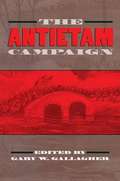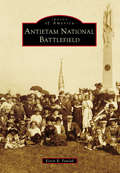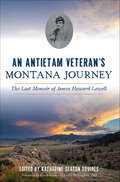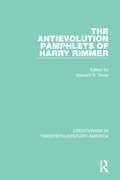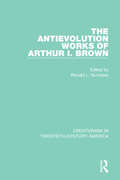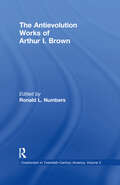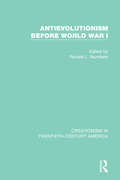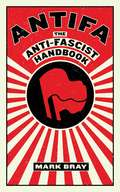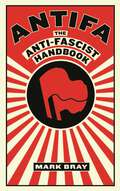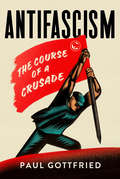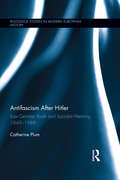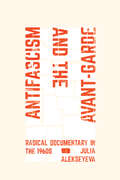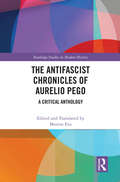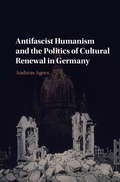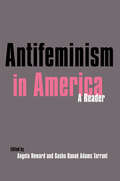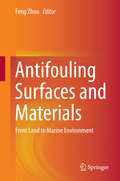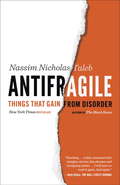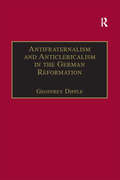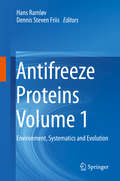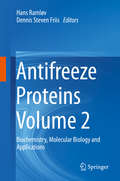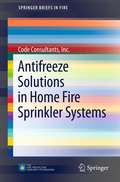- Table View
- List View
The Antietam Campaign (Military Campaigns of the Civil War)
by Gary GallagherA collection of essays examing different aspects of the antietam battle
Antietam National Battlefield (Images of America)
by Kevin R. PawlakApproximately 110,000 soldiers of the Union and Confederate armies fought along the banks of Antietam Creek in the bloodiest single-day battle in American history. In 12 hours of fighting, approximately 23,000 men fell, either killed, wounded, or missing, forever scarring the landscape around the town of Sharpsburg. Established as the Antietam Battlefield Site in 1890, Antietam National Battlefield became a National Park Service landmark in 1933. The park grew from 33 acres in the 1890s to encompassing over 3,000 acres today. Some of the Civil War's most recognizable landmarks now sit within its boundaries, including Dunker Church, Bloody Lane, and Burnside Bridge. The events that occurred across the fields and woodlots around Sharpsburg and along Antietam Creek bring hundreds of thousands of visitors to Antietam National Battlefield every year.
An Antietam Veteran's Montana Journey: The Lost Memoir of James Howard Lowell (Civil War Series)
by Katharine Seaton SquiresIn this recently unearthed memoir, Civil War veteran James Howard Lowell offers a firsthand account of his brutal journey west on a wagon train attacked by Indian Dog Soldiers. The Boston Yank staggers snow blind through a Laramie Plains blizzard to reach Salt Lake City, where he meets Brigham Young. In Montana, he joins an old forty-niner to work a mining claim, practices "tomahawk jurisprudence" in Fort Benton and builds a mackinaw to head downriver through Deadman Rapids to trade with the Crow and Gros Ventre tribes. Lowell's great-great-granddaughter edits this tale populated with colorful characters, narrow escapes and important historical events, such as the Baker Massacre. It features Lowell's letters to his sweetheart and Civil War correspondence.
The Antievolution Pamphlets of Harry Rimmer
by William Vance TrollingerOriginally published in 1995, The Antievolution Pamphlets of Harry Rimmer is the sixth volume in the series, Creationism in Twentieth Century America. The volume brings together original sources from the prominent evangelist and pastor Harry Rimmer. The consortium of pamphlets in this volume detail Rimmer’s antievolutionist sentiments, a notion which characterized his early writings. The pamphlets detail Rimmer’s rhetoric on evolution and science from the early part of the 20th century as he travelled across America to disseminate his writings. The works in this volume address Rimmer’s polemic on the danger posed by modern science and the consequential disassociation with religion. While Rimmer did not discount science itself, he argued for, what he termed, ‘true science’, claiming that modern science was based only in scientific opinion and not fact. As a self-proclaimed scientist, these writings take a unique view of the relationship between religion and science from this period through Rimmer’s dual nature as both scientist and pastor. This volume will be of great interest to historians of natural history, science and religion.
The Antievolution Pamphlets of William Bell Riley
by William Vance TrollingerOriginally published in 1995, The Antievolution Pamphlets of William Bell Riley is the fourth volume in the series, Creationism in Twentieth Century America, reissued in 2021. The volume comprises of nine antievolution pamphlets written by William Bell Riley during the interwar years. The pamphlets detail Riley’s antievolutionist ideas and activities, and the book attempts to place the work in the larger contexts of Riley’s career, as well as discussing the pamphlets included. The collection will be of especial interest to natural historians, and theologians as well as academics of philosophy, and history.
The Antievolution Works of Arthur I. Brown
by Ronald L. NumbersOriginally published in 1995, The Antievolution Works of Arthur I. Brown is the third volume in the series, Creationism in Twentieth Century America. The volume brings together original sources from the prominent surgeon and creationist Arthur I. Brown. Brown discredited evolution as it was contrary to the ‘clear statements of scripture’ which he believed infallible, stating evolution instead to be both a hoax and ‘a weapon of Satan’. The works included focus on Brown’s polemic through his early twentieth century writings. The essays focus on his scientific investigations and provide a negative commentary upon Darwin’s theory of evolution instead focusing on biblical explanations for evolution. As a scientist Brown’s unique view of evolution from a creationist and scientific viewpoint provides a fascinating lens through which to view the historical debates surrounding evolution and provides a unique insight into how Darwinian theory affected both the scientific and religious communities. This book will be of interest to natural historians, and theologians as well as academics of philosophy and history.
The Antievolution Works of Arthur I. Brown
by Ronald L. NumbersFirst published in 1995. Routledge is an imprint of Taylor & Francis, an informa company.
Antievolutionism Before World War I
by Ronald L. NumbersOriginally published in 1995, Antievolutionism Before World War I is the first volume in the series, Creationism in Twentieth Century America, reissued in 2021. The volume brings together original sources from the beginning of the twentieth century, critiquing Darwinism and the theory of natural selection. The sources included in this collection debate the role of natural selection in evolution, as well wider aspects of Darwinian theory from a creationist stance. The essays feature prominent figures from the period in the fields of naturalism, philosophy and theology and includes contributions from Alexander Patterson, Eberhard Dennert, Luther Tracy Townsend and George Frederick Wright. The collection will be of especial interest to natural historians, and theologians as well as academics of philosophy, geology and history.
Antifa: The Antifascist Handbook
by Mark Bray“Focused and persuasive... Bray’s book is many things: the first English-language transnational history of antifa, a how-to for would-be activists, and a record of advice from anti-Fascist organizers past and present.”--THE NEW YORKER"Insurgent activist movements need spokesmen, intellectuals and apologists, and for the moment Mark Bray is filling in as all three... The book’s most enlightening contribution is on the history of anti-fascist efforts over the past century, but its most relevant for today is its justification for stifling speech and clobbering white supremacists."--THE WASHINGTON POST, Carlos Lozada"An excellent primer and essential reading."--COUNTER PUNCHIn the wake of tragic events in Charlottesville, VA, and Donald Trump's initial refusal to denounce the white nationalists behind it all, the "antifa" opposition movement is suddenly appearing everywhere. But what is it, precisely? And where did it come from? As long as there has been fascism, there has been anti-fascism — also known as “antifa.” Born out of resistance to Mussolini and Hitler in Europe during the 1920s and ’30s, the antifa movement has suddenly burst into the headlines amidst opposition to the Trump administration and the alt-right. They could be seen in news reports, often clad all in black with balaclavas covering their faces, demonstrating at the presidential inauguration, and on California college campuses protesting far-right speakers, and most recently, on the streets of Charlottesville, VA, protecting, among others, a group of ministers including Cornel West from neo-Nazi violence. (West would later tell reporters, "The anti-fascists saved our lives.")Simply, antifa aims to deny fascists the opportunity to promote their oppressive politics, and to protect tolerant communities from acts of violence promulgated by fascists. Critics say shutting down political adversaries is anti-democratic; antifa adherents argue that the horrors of fascism must never be allowed the slightest chance to triumph again.In a smart and gripping investigation, historian and former Occupy Wall Street organizer Mark Bray provides a detailed survey of the full history of anti-fascism from its origins to the present day — the first transnational history of postwar anti-fascism in English. Based on interviews with anti-fascists from around the world, Antifa details the tactics of the movement and the philosophy behind it, offering insight into the growing but little-understood resistance fighting back against fascism in all its guises.
Antifa: The anti-fascist handbook
by Mark BraySo long as there has been fascism, there has been anti-fascism—also known as "antifa." Born out of resistance to Mussolini and Hitler in Europe during the 1920s and '30s, the antifa movement has suddenly burst into the headlines amid opposition to the Trump administration, the rise of the alt-right, and the resurgence of white supremacist groups such as the Ku Klux Klan. Now, in a smart and gripping investigation, historian and former Occupy Wall Street organizer Mark Bray provides a one-of-a-kind look inside the movement, including a detailed survey of antifa's history from its origins to the present day—the first transnational history of postwar anti-fascism in English. Based on interviews with anti-fascists from around the world, Antifa details the tactics of the movement and the philosophy behind it, offering insight into the growing but little-understood resistance fighting back against the alt-right.
Antifascism: The Course of a Crusade
by Paul GottfriedA conservative take on the antifascist movementAntifascism argues that current self-described antifascists are not struggling against a reappearance of interwar fascism, and that the Left that claims to be opposing fascism has little in common with any earlier Left, except for some overlap with critical theorists of the Frankfurt School. Paul Gottfried looks at antifascism from its roots in early twentieth-century Europe to its American manifestation in the present. The pivotal development for defining the present political spectrum, he suggests, has been the replacement of a recognizably Marxist Left by an intersectional one. Political and ideological struggles have been configured around this new Left, which has become a dominant force throughout the Western world. Gottfried discusses the major changes undergone by antifascist ideology since the 1960s, fascist and antifascist models of the state and assumptions about human nature, nationalism versus globalism, the antifascism of the American conservative establishment, and Antifa in the United States. Also included is an excursus on the theory of knowledge presented by Thomas Hobbes in Leviathan. In Antifascism Gottfried concludes that promoting a fear of fascism today serves the interests of the powerful—in particular, those in positions of political, journalistic, and educational power who want to bully and isolate political opponents. He points out the generous support given to the intersectional Left by multinational capitalists and examines the movement of the white working class in Europe—including former members of Communist parties—toward the populist Right, suggesting this shows a political dynamic that is different from the older dialectic between Marxists and anti-Marxists.
Antifascism After Hitler: East German Youth and Socialist Memory, 1949-1989 (Routledge Studies in Modern European History #27)
by Catherine PlumAntifascism After Hitler investigates the antifascist stories, memory sites and youth reception that were critical to the success of political education in East German schools and extracurricular activities. As the German Democratic Republic (GDR) promoted national identity and socialist consciousness, two of the most potent historical narratives to permeate youth education became tales of communist resistors who fought against fascism and the heroic deeds of the Red Army in World War II. These stories and iconic images illustrate the message that was presented to school-age children and adolescents in stages as they advanced through school and participated in the official communist youth organizations and other activities. This text delivers the first comprehensive study of youth antifascism in the GDR, extending scholarship beyond the level of the state to consider the everyday contributions of local institutions and youth mentors responsible for conveying stories and commemorative practices to generations born during WWII and after the defeat of fascism. While the government sought to use educators and former resistance fighters as ideological shock troops, it could not completely dictate how these stories would be told, with memory intermediaries altering at times the narrative and message. Using a variety of primary sources including oral history interviews, the author also assesses how students viewed antifascism, with reactions ranging from strong identification to indifference and dissent. Antifascist education and commemoration were never simply state-prescribed and were not as "participation-less" as some scholars and contemporary observers claim, even as educators fought a losing battle to maintain enthusiasm.
Antifascism and Sociology: Gino Germani 1911-1979
by Ana Alejandra GermaniIn this fascinating account of the master social scientist and policy innovator, Gino Germani, written by his daughter, the reader will find a rich social and intellectual history. Germani's life traversed Italy under Mussolini's fascism, Argentina under Peronism, and North America during the glorious days of the social sciences' postwar expansion. With high irony, the biography concludes with Germani's return to Naples, Italy, as what Ana Germani correctly calls "an outsider in the homeland." This is a volume that should be uniquely appealing to area specialists, social psychologists, and those concerned with the cross-currents of politics and society. From his youth in Italy, which he left as a result of persecution by the Fascist authorities, through his long and distinguished career in international social science, and a career carved out in a series of exiles, Germani maintained a unity of purpose based on a liberal world outlook in political terms and a struggle against totalitarianism. Social science was the cement that bound Germani's affirmations of democracy and his opposition to dictatorship. In Argentina, Germani is recognized as the founder of modern scientific sociology. There as elsewhere, his work was grounded on the presumption that a biometric society was the ground on which all science develops. Living and working during one of the most fertile periods in the development of social research in Argentina, Germani was the central protagonist of its most fertile period. Argentina served as a central focal point for discussion and debate on the practices of modern societies and the cultural forms. Whether in Italy, Argentina, or the United States, German's work took seriously the individual and transpersonal events that helped form social structures of modernization. The book is rich in details, providing a full bibliography of the works of Germani, his relationships with foundations, universities and personnel, and brief profiles of individuals who worked with and knew him.
Antifascism and the Avant-Garde: Radical Documentary in the 1960s
by Julia AlekseyevaLeftist filmmakers of the 1960s revolutionized the art of documentary. Often inspired by the radical art of the Soviet 1920s, filmmakers in countries like France and Japan dared to make film form a powerful weapon in the fight against fascism, weaving fiction into nonfiction and surrealism with neorealism to rupture everyday ways of being, seeing, and thinking. Through careful readings of Matsumoto Toshio, Jean-Luc Godard, Chris Marker, Agnès Varda, Hani Susumu, and others, Julia Alekseyeva shows that avant-garde documentary films of the 1960s did not strive to inoculate the viewer with the ideology of Truth but instead aimed to unveil and estrange, so that viewers might approach capitalist, imperialist, and fascist media with critical awareness. Antifascism and the Avant-Garde thus provides a transnational ecology of antifascist art that resonates profoundly with our current age.
The Antifascist Chronicles of Aurelio Pego: A Critical Anthology (Routledge Studies in Modern History)
by Montse FeuThe Antifascist Chronicles of Aurelio Pego: A Critical Anthology collects and contextualizes Pego’s 118 literary chronicles published between 1940 and 1967 in the periodical España Libre, New York. The satire of this household name in the US Spanish-language press lambasted Fascist Spain, lampooned American diplomatic relations with Francisco Franco, and mocked the Spanish exiles’ unsuccessful efforts to liberate Spain from the dictator. Pego’s journalism showed deep dedication to the public good with his publication of uncensored information about the regime that alerted readers of the civil rights infringements in Fascist Spain. However, Pego delivered the hard truths of Fascist Spain cloaked in mockery. Humor was crucial in this political culture not only because it facilitated communicating Spanish news but also avoided mythical and totalitarian rhetorical resistance. The fragility of the alternative periodicals’ paper and the political persecution against dissident voices has caused that much of this antifascist print culture has been lost. However, Pego’s chronicles prove that US Hispanic antifascism was vibrant. The anthology puts forward the understudied work of antifascists in the United States and provides evidence of their activism. Its preservation is an exercise of collective memory and a place of resistance to an elitist and fascist archive.
Antifascist Humanism and the Politics of Cultural Renewal in Germany
by Andreas AgocsAntifascism is usually described as either a political ideology of activists and intellectuals confronting the dictatorships of Hitler and Mussolini, or as a cynical tool that justified the Stalinist expansion of communism in Europe. Andreas Agocs widens our understanding of antifascism by placing it in the context of twentieth-century movements of 'cultural renewal'. He explores the concept of 'antifascist humanism', the attempt by communist and liberal intellectuals and artists to heal the divisions of Nazism by reviving the 'other Germany' of classical Weimar. This project took intellectual shape in German exile communities in Europe and Latin America during World War II and found its institutional embodiment in the Cultural League for Democratic Renewal in Soviet-occupied Berlin in 1945. During the emerging Cold War, antifascist humanism's uneasy blend of twentieth-century mass politics and cultural nationalism became the focal point of new divisions in occupied Germany and the early German Democratic Republic. This study traces German traditions of cultural renewal from their beginnings in antifascist activism to their failure in the emerging Cold War.
Antifeminism in America: A Historical Reader (Antifeminism In America: A Collection Of Readings From The Literature Of The Opponents To U. S. Feminism, 1848 To The Present Ser. #2)
by Gillian SwansonThe documents in this paperback inform the reader's understanding and appreciation of the social and political context of opposition in which the advocates of women's rights labored from 1848 to 1996. Arranged in six parts by historical periods, these original articles from mainstream magazines, specialized and academic journals, and books display the tone and substance of opposition to women's rights as it appeared in popular literature. The selections reflect the public campaign, fought in the popular press, of opponents to the fundamental goal of all aspects of movement for women's rights, to challenge the gender system by advocating equality for women.
Antiformalist, Unrevolutionary, Illiberal Milton: Political Prose, 1644-1660
by William WalkerOn the basis of a close reading of Milton's major published political prose works from 1644 through to the Restoration, William Walker presents the anti-formalist, unrevolutionary, illiberal Milton. Walker shows that Milton placed his faith not so much in particular forms of government as in statesmen he deemed to be virtuous. He reveals Milton's profound aversion to socio-political revolution and his deep commitments to what he took to be orthodox religion. He emphasises that Milton consistently presents himself as a champion not of heterodox religion, but of 'reformation'. He observes how Milton's belief that all men are not equal grounds his support for regimes that had little popular support and that did not provide the same civil liberties to all. And he observes how Milton's powerful commitment to a single religion explains his endorsement of various English regimes that persecuted on grounds of religion. This reading of Milton's political prose thus challenges the current consensus that Milton is an early modern exponent of republicanism, revolution, radicalism, and liberalism. It also provides a fresh account of how the great poet and prose polemicist is related to modern republics that think they have separated church and state.
Antifouling Surfaces and Materials: From Land to Marine Environment
by Feng ZhouThis book reviews the development of antifouling surfaces and materials for both land and marine environments, with an emphasis on marine anti biofouling. It explains the differences and intrinsic relationship between antifouling in land and marine environments, which are based on superhydrophobicity and superhydrophilicity respectively. It covers various topics including biomimetic antifouling and self-cleaning surfaces, grafted polymer brushes and micro/nanostructure surfaces with antifouling properties, as well as marine anti biofouling. Marine anti biofouling includes both historical biocidal compounds (tributyltin, copper and zinc) and current green, non-toxic antifouling strategies. This book is intended for those readers who are interested in grasping the fundamentals and applications of antifouling. Feng Zhou is a professor at the State Key Laboratory of Solid Lubrication, Lanzhou Institute of Chemical Physics, Chinese Academy of Sciences.
Antifragile: Things That Gain from Disorder (Incerto #3)
by Nassim Nicholas TalebAntifragile is a standalone book in Nassim Nicholas Taleb's landmark Incerto series, an investigation of opacity, luck, uncertainty, probability, human error, risk, and decision-making in a world we don't understand. The other books in the series are Fooled by Randomness, The Black Swan, and The Bed of Procrustes.Nassim Nicholas Taleb, the bestselling author of The Black Swan and one of the foremost thinkers of our time, reveals how to thrive in an uncertain world. Just as human bones get stronger when subjected to stress and tension, and rumors or riots intensify when someone tries to repress them, many things in life benefit from stress, disorder, volatility, and turmoil. What Taleb has identified and calls "antifragile" is that category of things that not only gain from chaos but need it in order to survive and flourish. In The Black Swan, Taleb showed us that highly improbable and unpredictable events underlie almost everything about our world. In Antifragile, Taleb stands uncertainty on its head, making it desirable, even necessary, and proposes that things be built in an antifragile manner. The antifragile is beyond the resilient or robust. The resilient resists shocks and stays the same; the antifragile gets better and better. Furthermore, the antifragile is immune to prediction errors and protected from adverse events. Why is the city-state better than the nation-state, why is debt bad for you, and why is what we call "efficient" not efficient at all? Why do government responses and social policies protect the strong and hurt the weak? Why should you write your resignation letter before even starting on the job? How did the sinking of the Titanic save lives? The book spans innovation by trial and error, life decisions, politics, urban planning, war, personal finance, economic systems, and medicine. And throughout, in addition to the street wisdom of Fat Tony of Brooklyn, the voices and recipes of ancient wisdom, from Roman, Greek, Semitic, and medieval sources, are loud and clear. Antifragile is a blueprint for living in a Black Swan world. Erudite, witty, and iconoclastic, Taleb's message is revolutionary: The antifragile, and only the antifragile, will make it.Praise for Antifragile "Ambitious and thought-provoking . . . highly entertaining."--The Economist "A bold book explaining how and why we should embrace uncertainty, randomness, and error . . . It may just change our lives."--Newsweek "Revelatory . . . [Taleb] pulls the reader along with the logic of a Socrates."--Chicago Tribune "Startling . . . richly crammed with insights, stories, fine phrases and intriguing asides . . . I will have to read it again. And again."--Matt Ridley, The Wall Street Journal "Trenchant and persuasive . . . Taleb's insatiable polymathic curiosity knows no bounds. . . . You finish the book feeling braver and uplifted."--New Statesman "Antifragility isn't just sound economic and political doctrine. It's also the key to a good life."--Fortune "At once thought-provoking and brilliant."--Los Angeles TimesFrom the Hardcover edition.
Antifragile Systems and Teams
by Dave ZwiebackHow Can DevOps Make You Antifragile?All complex computer systems eventually break, despite all of the heavy-handed, bureaucratic change-management processes we throw at them. But some systems are clearly more fragile than others, depending on how well they cope with stress. In this O’Reilly report, Dave Zwieback explains how the DevOps methodology can help make your system antifragile.Systems are fragile when organizations are unprepared to handle changing conditions. As generalists adept at several roles, DevOps practitioners adjust more easily to the fast pace of change. Rather than attempt to constrain volatility, DevOps embraces disorder, randomness, and impermanence to make systems even better.This concise report covers:Why Etsy, Netflix, and other antifragile companies constantly introduce volatility to test and upgrade their systemsHow DevOps removes the schism between developers and operations, enlisting developers to deploy as well as buildUsing continual experimentation and minor failures to make critical adjustments—and discover breakthroughsHow an overreliance on measurement and automation can make systems fragileWhy sharing increases trust, collaboration, and tribal knowledgeDownload this free report and learn how the DevOps philosophy of Culture, Automation, Measurement, and Sharing makes use of changing conditions and even embarrassing mistakes to help improve your system—and your organization.Dave Zwieback has been managing large-scale, mission-critical infrastructure and teams for 17 years.
Antifraternalism and Anticlericalism in the German Reformation: Johann Eberlin von Günzburg and the Campaign Against the Friars (St Andrews Studies in Reformation History)
by Geoffrey DippleMany of the leading figures of the Reformation and many of their most able opponents came from among the ranks of the Franciscan Order. This Order became the focus of attack in a pamphlet war waged against it in 1523 by converts to the Reformation. These criticisms were based on arguments by Luther in his Judgement on Monastic Vows, and the pamphlets provided an important channel for these views. Luther’s arguments were also reinforced by criticisms of the mendicant orders drawn from medieval polemical and satirical literature. The campaign of 1523 brought together both Reformation and pre-Reformation anticlerical themes. In this book Geoffrey Dipple looks at the perception of the Franciscan order in the 15th and 16th centuries, placing the attacks firmly in the context of late medieval inter-clerical rivalries. He looks particularly at the anticlerical polemics of one of the primary participants - Johann Eberlin von Günzburg - the most vocal of the Franciscan’s critics.
Antifreeze Proteins Volume 1: Environment, Systematics and Evolution
by Hans Ramløv Dennis Steven FriisThis first volume provides a comprehensive overview on evolutionary, environmental and systematic aspects of antifreeze proteins. It shortly explains the physical properties of ice and further intelligibly describes the biology of the antifreeze proteins in different organisms, and offers a detailed insight into their history of evolution. In addition the book discusses the status of the current knowledge and ongoing research and highlights also those parts, where further investigation needs to be done. Together with the second volume on the biochemistry and molecular biology of antifreeze proteins, this book represents a unique, comprehensive work and a must-have for students and scientists in biochemistry, evolution, physiology and physical chemistry.
Antifreeze Proteins Volume 2: Biochemistry, Molecular Biology and Applications
by Hans Ramløv Dennis Steven FriisThis second volume, written in four parts, offers the reader a thorough review on molecular, structural and applied aspects of antifreeze proteins. The first part treats the structure-function relationship and the physicochemical properties of antifreeze proteins; the second part provides insight into molecular mechanisms affected by antifreeze proteins; the third part presents some of the potential applications in various professional sectors and in the last part the book content is summarized and future research directions and ideas are discussed. Together with the first volume on the environment, systematic and evolution of antifreeze proteins, this book represents a unique, comprehensive work and a must-have for students and scientists in biochemistry, molecular biology, biotechnology and physical chemistry.
Antifreeze Solutions in Home Fire Sprinkler Systems: Antifreeze Solutions In Home Fire Sprinkler Systems (SpringerBriefs in Fire)
by Inc. Code ConsultantsAntifreeze Solutions in Home Fire Sprinkler Systems examines the usage of antifreeze solutions in residential sprinklers, and analyzes their effectiveness in controlling a fire condition and aiding in containment. The book also investigates the possibility of a large-scale ignition occurring from solutions of varying mixtures, and proposes the optimal ones for reducing flammability. Antifreeze Solutions in Home Fire Sprinkler Systems is designed for practitioners as a reference guide for handling antifreeze solutions in residential sprinkler systems. Researchers working in a related field will also find the book valuable.
